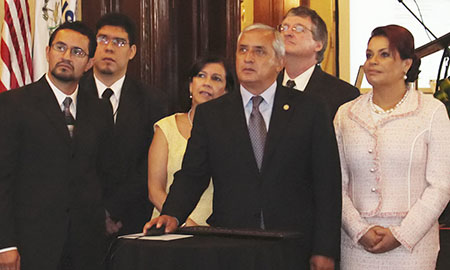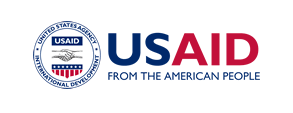The Health Policy Project ended in 2016. Work continued under Health Policy Plus (HP+) until 2022.
NEWS & VIEWS
HEPP and Guatemalan government officials launch an electronic portal to support decisionmaking in the education sector.
Posted August 12, 2013
 |
| Guatemalan President Otto Pérez Molina (center), Vice President Roxana Baldetti (right), and USAID Mission Director Kevin Kelly oversee the live launch of the user-friendly dashboard. |
GUATEMALA CITY, Guatemala—President Otto Pérez Molina joined the Minister of Education and other officials July 2 to launch a national web portal to support decisionmaking in the education sector. The portal was developed to provide government officials, school personnel, groups involved in education, and the public with updated information on expenditures, student/teacher ratios, and other indicators of educational quality. More than 200 educational and governmental officials, nongovernmental organizations, and news media participated in the launch.
“I thank USAID and the Health and Education Policy Project for their support building this system,” said President Pérez. “Being able to access relevant, practical information is fundamental for decision-making, planning targeted programs, and for evaluating and improving the implementation of activities.”
The “Electronic Wall of Transparency,” also referred to as the Social Information System of the Ministry of Education (MINEDUC), provides a national platform to monitor implementation of the government’s commitment to increasing access to education services, especially among the poor. It is an easy-to-access, user-friendly tool that can be used by officials, technical staff, and civil society to compare resources available in different communities, identify trends in educational outcomes over time, and find reliable data to advocate for improvements in educational programming. The new portal was developed by the Health and Education Policy Project (HEPP) as part of wider efforts by the U.S. Agency for International Development (USAID) to support accountability and transparency in governance, both within and beyond the education sector. It is available in Spanish, English, and five Mayan languages at www.estadistica.mineduc.gob.gt.
“This information system of the MOE is a fundamental part of what will be a national system of social information,” said Vice President Roxana Baldetti, who spoke at the portal launch. “It is a key element in the policy of transparency of the government, and through which the public can track the results of all social programs implemented by the government.”
President Pérez, Vice President Baldetti, USAID Mission Director Kevin Kelly, and more than 200 other participants, including Guatemalan congressmen, mayors, heads of international cooperation agencies, and stakeholders from the public and private sectors witnessed a demonstration of the system’s features and its capability to promote accountability. The education portal is the first component of a larger National Social Information System to use an “open data” environment designed to promote transparency. Another component led by the Ministry of Social Development and Health will soon be added, part of the government’s overall effort to expand the reach of health, education, and governmental services to the poor.
“There is no better way to assure oversight than to engage the citizenry,” said President Pérez. The public will be a “principal actor” in its use, he added, and encouraged active participation by the education community.
Guatemala is the most populated country in Central America. Many Guatemalans live in extreme poverty and face challenges accessing health services and education—particularly in rural areas of the country. This is reflected in high rates of infant and maternal mortality, and a considerable drop in enrollment rates--especially among indigenous groups--from primary school to secondary school. On average, indigenous Guatemalans attend school only 3.8 years, compared with other Guatemalans, who average 6.5 years of schooling. An important step in holding authorities accountable for improvements in educational services is knowing where such gaps exist.
“Access to information tools that are easy to use inspires confidence in the government, and sharing information on strengths and weaknesses demonstrates transparency in public administration,” said USAID Mission Director Kelly, speaking at the launch. These efforts are important for development, he said, because “education has long-term positive effects on the lives of individuals, and on investment, health, and gender equality.”
By identifying geographic gaps in service provision, the education portal, which draws on a database of education indicators, helps government agencies improve the management of social programs and better target resources to meet citizens’ needs. Users ranging from policymakers to parents and teachers can view the comparison between program coverage and the incidence of general poverty in Guatemala. Such data also serves as an evidence base for health officials and social services agencies to use in advocating for increased funding and resources to provide health and education to poor people, especially those living in remote areas.
Technological innovation
Guatemala’s initial data processing system to store information on education indicators was initially developed in 1991 with funding from USAID. The system evolved over time to provide greater capabilities for use by departmental, municipal, and local officials working to improve the quality of education. But end users often experienced difficulty accessing and analyzing the information needed to support their planning, monitoring, and decision-making activities.
In 2011, HEPP begin assisting the Ministry of Education with the information system. A key focus of its efforts was to make the system easier for non-technical users. The new, highly visual portal utilizes geo-referencing and mapping technology, coupled with innovative tools that allow users to access and analyze current health and education data without reliance on computer professionals—all through fast and user-friendly interfaces employed widely in business intelligence systems. Because broad participation in national efforts to improve education is so important, HEPP is also working to support civil society groups, such as networks of indigenous women, to monitor the quality of education services. The new portal strengthens the capabilities of both the MOE and civil society in planning, monitoring, and decision-making.
“We are looking for active participation from the education community,” said Ms. Cynthia del Águila de Saenz de Tejada, Guatemala’s Minister of Education, as she demonstrated the portal’s user-friendly interface at the launch, which was widely covered by news media in Guatemala. “Using the portal, you can find information about every school [in the country].”
|
FOR MORE INFORMATION: The “Electronic Wall of Transparency,” a web-based education portal developed with support and technical assistance from the USAID-funded Health and Education Policy Project (HEPP), presents the latest available information from the Guatemalan Educational Indicator System. The portal systematically gathers, stores, and analyzes data in the social services sector as part of the overall effort to expand the reach of health, education, and governmental services to the poor. It is easy to access, easy to use, and is available in Spanish, English, and five Mayan languages. It has been posted on the MOE’s website and is available at no cost to anyone wishing to use it. Visit www.estadistica.mineduc.gob.gt |
What's New
- Something to Build On: “Innovation Exchange” Celebrates the Health Policy Project’s Close and a New Beginning
- What Will it Take for Tanzania to Achieve ART Targets and Ensure Long-Term Sustainability of the HIV Response?
- Helping Kenya’s County Leaders Advocate for Increased Health Investments
- HPP Holds Working Meeting on Ensuring Responsible PEPFAR Transitions for Key Populations
- Health Policy Project Celebrates 2016 International Women's Day
- HPP Staff Participate in White House Conference on HIV Stigma Reduction

